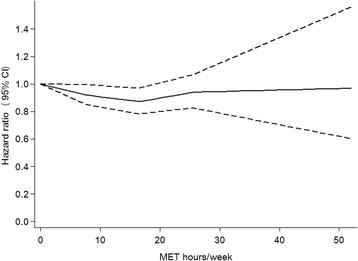Associations of leisure-time, occupational, and commuting physical activity with risk of depressive symptoms among Japanese workers: a cohort study
- PMID: 26384967
- PMCID: PMC4575427
- DOI: 10.1186/s12966-015-0283-4
Associations of leisure-time, occupational, and commuting physical activity with risk of depressive symptoms among Japanese workers: a cohort study
Abstract
Background: Leisure-time physical activity is associated with a lower risk of depression. However, the precise shape of the dose-response relationship remains elusive, and evidence is scarce regarding other domains of activity. We prospectively investigated associations of physical activity during leisure, work, and commuting with risk of depressive symptoms in Japanese workers.
Methods: We conducted a cohort study of 29 082 Japanese workers aged 20-64 years without psychiatric disease (including depressive symptoms) at baseline with a maximum 5-year follow-up. Physical activity was self-reported. Depressive symptoms were assessed by 13 self-report questions on subjective symptoms. Hazard ratios (HRs) and 95% confidence intervals (CIs) for incidence of depressive symptoms were calculated using Cox regression analysis.
Results: During a mean follow-up of 4.7 years, 6177 developed depressive symptoms. Leisure exercise showed a U-shaped association with risk of depressive symptoms adjusting for potential confounders. Additional adjustment for baseline depression scores attenuated the association, but it remained statistically significant (P for trend = 0.037). Compared with individuals who engaged in sedentary work, the HR (95% CI) was 0.86 (0.81, 0.92) for individuals who stand or walk during work and 0.90 (0.82, 0.99) for those who are fairly active at work. However, the association disappeared after adjusting for baseline depression scores. Walking to and from work was not associated with depressive symptoms.
Conclusions: The findings suggest that leisure-time exercise has a U-shaped relation with depressive symptoms in Japanese workers. Health-enhancing physical activity intervention may be needed for individuals who engage in sedentary work.
Figures

Similar articles
-
The association of leisure-time physical activity and walking during commuting to work with depressive symptoms among Japanese workers: A cross-sectional study.J Occup Health. 2020 Jan;62(1):e12120. doi: 10.1002/1348-9585.12120. J Occup Health. 2020. PMID: 32515911 Free PMC article.
-
Intensity of Leisure-Time Exercise and Risk of Depressive Symptoms Among Japanese Workers: A Cohort Study.J Epidemiol. 2018 Feb 5;28(2):94-98. doi: 10.2188/jea.JE20170009. Epub 2017 Oct 28. J Epidemiol. 2018. PMID: 29093360 Free PMC article.
-
Leisure-time, occupational, and commuting physical activity and risk of type 2 diabetes in Japanese workers: a cohort study.BMC Public Health. 2015 Oct 2;15:1004. doi: 10.1186/s12889-015-2362-5. BMC Public Health. 2015. PMID: 26431831 Free PMC article.
-
Physical activity, sedentary behavior, and postnatal depressive symptoms: a review.Am J Prev Med. 2013 Aug;45(2):217-27. doi: 10.1016/j.amepre.2013.04.004. Am J Prev Med. 2013. PMID: 23867030 Review.
-
Should workers be physically active after work? Associations of leisure-time physical activity with cardiovascular and all-cause mortality across occupational physical activity levels-An individual participant data meta-analysis.J Sport Health Sci. 2024 Sep 12;14:100987. doi: 10.1016/j.jshs.2024.100987. Online ahead of print. J Sport Health Sci. 2024. PMID: 39277081 Free PMC article. Review.
Cited by
-
Personal lifestyle as a resource for work engagement.J Occup Health. 2017 Jan 24;59(1):17-23. doi: 10.1539/joh.16-0167-OA. Epub 2016 Nov 22. J Occup Health. 2017. PMID: 27885245 Free PMC article.
-
Mediating Effects of Trait Anxiety and State Anxiety on the Effects of Physical Activity on Depressive Symptoms.Int J Environ Res Public Health. 2023 Mar 30;20(7):5319. doi: 10.3390/ijerph20075319. Int J Environ Res Public Health. 2023. PMID: 37047935 Free PMC article.
-
Associations of physical activity and sedentary time with psychological distress among Japan self-defense forces personnel dispatched overseas: a prospective cohort study.J Occup Health. 2024 Jan 4;66(1):uiae069. doi: 10.1093/joccuh/uiae069. J Occup Health. 2024. PMID: 39551934 Free PMC article.
-
The association of leisure-time physical activity and walking during commuting to work with depressive symptoms among Japanese workers: A cross-sectional study.J Occup Health. 2020 Jan;62(1):e12120. doi: 10.1002/1348-9585.12120. J Occup Health. 2020. PMID: 32515911 Free PMC article.
-
Intensity of Leisure-Time Exercise and Risk of Depressive Symptoms Among Japanese Workers: A Cohort Study.J Epidemiol. 2018 Feb 5;28(2):94-98. doi: 10.2188/jea.JE20170009. Epub 2017 Oct 28. J Epidemiol. 2018. PMID: 29093360 Free PMC article.
References
-
- World Health Organization . Depression. Geneva: World Health Organization; 2012.
Publication types
MeSH terms
LinkOut - more resources
Full Text Sources
Other Literature Sources
Medical

